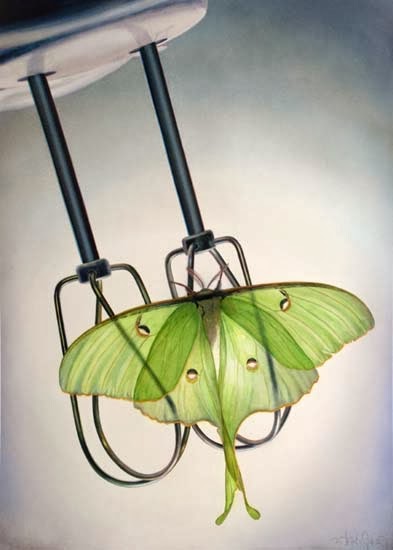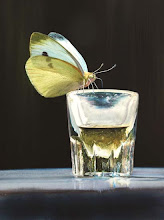
Paul Pitsker, Erasing [detail], 2007, watercolor, 20 x 15 in.
You can read more about the hot contemporary art scene in Palm Desert in Art and Antiques, if you're curious...
One highlight from the trip I have to mention was our stop at the Wheel Inn in Cabazon. Perhaps, like me, you have driven past those landmark larger-than-life dinosaurs on the 10 freeway a bizillion times without stopping -- or, even if you haven't, you may recall them from PeeWee's Big Adventure. Well, the restaurant at their feet (more or less) is so worth a visit -- at least, for an early morning breakfast it was a dream. From the vintage beaded light fixtures, to the ubiquitous steer horns and scrolling aquarium motion lamps, to the 100% rayon leopard-print shirts worn by the staff, to the petrified prospector and his mule greeting you out front, this place is the real deal -- a genuine living museum of time-warped roadside kitsch Americana. Check it out before it is lost to the outlet-center corporate franchise sprawl and tribal casino mega-development swallowing up the desert all around it.
In other news...
I see a lot of art around town but rarely get the chance to sit down and write about it. But here are some hightlights from my Saturday rounds in November...

Rico LeBrun at Koplin del Rio
I remember being greeted by the flayed and tormented figures in Rico LeBrun's Genesis as I exited my college dining hall three times daily way back in the previous century, or thereabouts. Of all the chaos and suffering depicted in that mural, I was most haunted by the figure of Job heaving his massive, crippled carcass on a rough-hewn crutch while grimacing bitterly up at the heavens. The cycle of LeBrun drawings currently showing at Koplin del Rio may be less overtly stomach-churning, but it offers no less fascinating glimpses into the process of an artist for whom drawing was clearly the preferred vehicle of offroad exploration into the darker thickets of his own psyche. While inspired by Dante's Inferno, these are not literal book illustrations. It is instead the broader horror arising from LeBrun's contemplation of eternal torment in infernal darkness that seems to have inspired these rapidly executed and expressive drawings. Their fluid gestural lines and ink washes describe intertwining figures and body parts that don't always resolve coherently but rather suggest interwoven, often symmetrical mandalas of human suffering.

Leigh Salgado at Avenue 50 Studios
I confess I looked at Leigh Salgado's recent work at Ave 50 Studios for quite some time (okay, minutes) before I realized the fragments of printed text embedded among her meticulously cut paper layers were hardly fragmentary at all when read backwords word by word. Oh, it's poetry, I thought in my distracted dullitude. It took me an embarassingly longer time to realize these were actually the remnants of player piano scrolls with song lyrics printed on them. My thoughts jumped immediately to Conlon Nancarrow, laboriously cutting his intricate and unplayable polyrhythms onto custom piano rolls in the mid-twentieth century. Salgado's work is no less intricate and laborious. Armed with an x-acto knife and a sharpie, she transforms ordinary paper into layers of complex patterns and textures resembling delicate lace, fishnet stockings, sensuous flesh, and lyrical abstraction, complemented nicely by the correspondingly complex shadows these works cast on the wall.

Tom Chambers at George Billis
Tom Chambers' beautifully staged color photographs at George Billis gallery call to mind Pre-Raphaelite paintings from the previous fin de siecle. Imagine John Everett Millais or Dante Gabriel Rossetti armed with a digital camera and you might get a sense of the painterly richness and allegorical density of these images.
Okay, that's it for now. I will be posting more new work of my own soon. Thanks for your interest, and have some happy holidays!




















